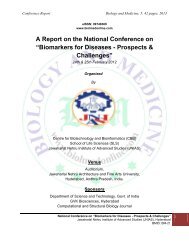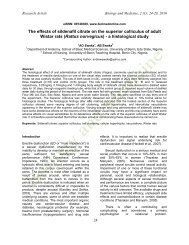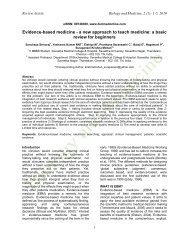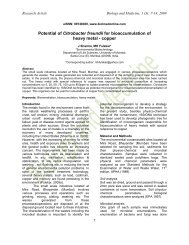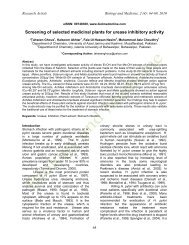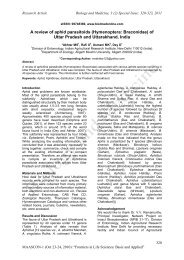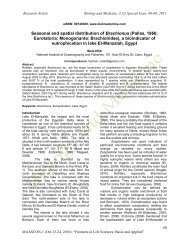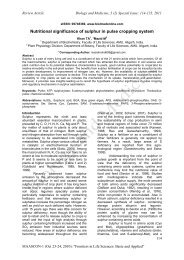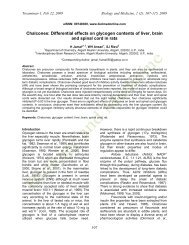Immunomodulatory effects of Tinospora cordifolia (Guduchi) on ...
Immunomodulatory effects of Tinospora cordifolia (Guduchi) on ...
Immunomodulatory effects of Tinospora cordifolia (Guduchi) on ...
Create successful ePaper yourself
Turn your PDF publications into a flip-book with our unique Google optimized e-Paper software.
Research Article Biology and Medicine, 3 (2) Special Issue: 134-140, 2011<br />
eliminati<strong>on</strong> <str<strong>on</strong>g>of</str<strong>on</strong>g> viruses, bacteria, fungi and<br />
protozoa (De Groote and Fang, 1995). The<br />
direct effect <str<strong>on</strong>g>of</str<strong>on</strong>g> the drug to the bacteria is<br />
significantly different as compared to the<br />
supernatants from cells treated with medium<br />
al<strong>on</strong>e as shown in Fig. 3. Though there is a<br />
little difference in the diameter <str<strong>on</strong>g>of</str<strong>on</strong>g> z<strong>on</strong>e <str<strong>on</strong>g>of</str<strong>on</strong>g><br />
inhibiti<strong>on</strong> in the indirect effect, the drug treated<br />
cell supernatant gives clear z<strong>on</strong>e <str<strong>on</strong>g>of</str<strong>on</strong>g> inhibiti<strong>on</strong><br />
as compared to untreated cell supernatant<br />
(Fig. 4). It appears that these are the primary<br />
mechanisms involving n<strong>on</strong>specific inducti<strong>on</strong> <str<strong>on</strong>g>of</str<strong>on</strong>g><br />
the immune system.<br />
One <str<strong>on</strong>g>of</str<strong>on</strong>g> the most promising recent<br />
alternatives to classical antibiotic treatment is<br />
the use <str<strong>on</strong>g>of</str<strong>on</strong>g> immunomodulators for enhancing<br />
host defense resp<strong>on</strong>ses (Tzianobos, 2000).<br />
Plant derived immunomodulatory compounds<br />
have also been used in traditi<strong>on</strong>al remedies for<br />
various medical problems and the<br />
investigati<strong>on</strong> <str<strong>on</strong>g>of</str<strong>on</strong>g> these sources has grown<br />
exp<strong>on</strong>entially in recent years. India has a rich<br />
traditi<strong>on</strong> in the treatment <str<strong>on</strong>g>of</str<strong>on</strong>g> many diseases by<br />
therapy with ‘Rasayans’. In Ayurveda,<br />
‘Rasayans’ are c<strong>on</strong>cerned with nourishing<br />
body and boosting immunity. They are also<br />
modulators <str<strong>on</strong>g>of</str<strong>on</strong>g> the immune system and <strong>on</strong>e<br />
such cell modulated by them is the<br />
macrophage. The macrophage is usually is in<br />
a quiescent state in a healthy individual, but in<br />
the presence <str<strong>on</strong>g>of</str<strong>on</strong>g> a pathogen or when treated<br />
with drug macrophage becomes activated<br />
(Singh et al., 2006). The effect <str<strong>on</strong>g>of</str<strong>on</strong>g> the BRM <strong>on</strong><br />
the activati<strong>on</strong> <str<strong>on</strong>g>of</str<strong>on</strong>g> quiescent resting<br />
macrophages was assayed by its secretory<br />
activity <str<strong>on</strong>g>of</str<strong>on</strong>g> factors like nitric oxide (assayed in<br />
the form <str<strong>on</strong>g>of</str<strong>on</strong>g> nitrite) and lysozyme which leads<br />
to the microbicidal activity <str<strong>on</strong>g>of</str<strong>on</strong>g> macrophages. In<br />
the present study, effect <str<strong>on</strong>g>of</str<strong>on</strong>g> <str<strong>on</strong>g>Guduchi</str<strong>on</strong>g><br />
(<str<strong>on</strong>g>Tinospora</str<strong>on</strong>g> <str<strong>on</strong>g>cordifolia</str<strong>on</strong>g>) as immunomodulator<br />
and Lipopolysaccharide (LPS), a bacterial<br />
endotoxin as a positive activator, was<br />
investigated by standard biochemical<br />
parameters <str<strong>on</strong>g>of</str<strong>on</strong>g> macrophage activati<strong>on</strong>.<br />
Lysozyme, which is secreted<br />
c<strong>on</strong>stitutively and in large amounts by<br />
macrophages, was found to be further<br />
increased in BRM treated macrophages.<br />
Lysozyme is highly active against grampositive<br />
species and deficiency in lysozyme<br />
producti<strong>on</strong> has been found to lead to<br />
susceptibility to Streptococcus pneum<strong>on</strong>iae<br />
(Shimada et al., 2008).<br />
The alcoholic and aqueous extracts <str<strong>on</strong>g>of</str<strong>on</strong>g><br />
T. <str<strong>on</strong>g>cordifolia</str<strong>on</strong>g> have been tested successfully for<br />
immunomodulatory properties (Thatte et al.,<br />
1987; Dahanukar et al., 1988; Thatte and<br />
Dahanukar, 1989; Rege et al., 1989, 1999;<br />
Dikshit et al., 2000; Manjrekar et al., 2000).<br />
Previous authors have reported findings that<br />
most <str<strong>on</strong>g>of</str<strong>on</strong>g> the therapeutic compounds in plants<br />
are polar in nature and require polar solvents<br />
for their extracti<strong>on</strong>. However, the ethanolic<br />
extract failed to show significant activity in the<br />
present study. The herb is being c<strong>on</strong>sumed by<br />
people since a l<strong>on</strong>g time.<br />
Today, it is becoming more and more<br />
clear that the products identified under the<br />
traditi<strong>on</strong>al or alternative medicines in vitro<br />
c<strong>on</strong>diti<strong>on</strong>s also stimulate the natural in vivo<br />
c<strong>on</strong>diti<strong>on</strong>s and thus may give the true directi<strong>on</strong><br />
to the problem. It would therefore suffice to<br />
extrapolate the in vitro observati<strong>on</strong>s to in vivo<br />
c<strong>on</strong>diti<strong>on</strong>s. There is thus a great need to<br />
understand how exactly pathogen survives in<br />
vivo c<strong>on</strong>diti<strong>on</strong>s and identify pathways unique<br />
to the intracellular envir<strong>on</strong>ment that could be<br />
utilized for the development <str<strong>on</strong>g>of</str<strong>on</strong>g> new and better<br />
drugs.<br />
C<strong>on</strong>clusi<strong>on</strong><br />
The results <str<strong>on</strong>g>of</str<strong>on</strong>g> present study show<br />
experimental basis <str<strong>on</strong>g>of</str<strong>on</strong>g> immunomodulati<strong>on</strong> by<br />
biological resp<strong>on</strong>se modifier (BRM). This study<br />
addresses a very pertinent questi<strong>on</strong> <str<strong>on</strong>g>of</str<strong>on</strong>g> biomedical<br />
sciences dealing with the scientific<br />
basis, particularly immunomodulatory <str<strong>on</strong>g>effects</str<strong>on</strong>g>,<br />
<str<strong>on</strong>g>of</str<strong>on</strong>g> the herbal medicine preparati<strong>on</strong>s <strong>on</strong> the<br />
macrophage activati<strong>on</strong>, as macrophages are<br />
known to represent the first line <str<strong>on</strong>g>of</str<strong>on</strong>g> defense<br />
against invading microorganisms or in a state<br />
<str<strong>on</strong>g>of</str<strong>on</strong>g> altered self.<br />
Acknowledgement<br />
This work was supported by a grant from<br />
Board <str<strong>on</strong>g>of</str<strong>on</strong>g> College and University Development<br />
(BCUD), University <str<strong>on</strong>g>of</str<strong>on</strong>g> Pune; Center for<br />
Advanced Studies (CAS), Department <str<strong>on</strong>g>of</str<strong>on</strong>g><br />
Zoology, University <str<strong>on</strong>g>of</str<strong>on</strong>g> Pune; and Department<br />
<str<strong>on</strong>g>of</str<strong>on</strong>g> Atomic Energy, Board <str<strong>on</strong>g>of</str<strong>on</strong>g> Research and<br />
Nuclear Science (DAE-BRNS), Govt. <str<strong>on</strong>g>of</str<strong>on</strong>g> India.<br />
References<br />
Beutler B, 2004. Innate immunity: An overview.<br />
Molecular Immunology, 40: 845–859.<br />
Broker R, Bhatt JV, 1953. Symposium <strong>on</strong> antibacterial<br />
substances from soil, plants and other<br />
sources: XV. Phagocytic coefficient as a measure<br />
for evaluating plant antibiotics. Indian Journal <str<strong>on</strong>g>of</str<strong>on</strong>g><br />
Pharmacy, 309-10.<br />
Dikshit V, Damre AS, Kulkarni KR, Gokhale A,<br />
Saraf MN, 2000. Preliminery screening <str<strong>on</strong>g>of</str<strong>on</strong>g><br />
immunocin for immunomodulatory activity. Indian<br />
Journal <str<strong>on</strong>g>of</str<strong>on</strong>g> Pharmaceutical Science, 62: 257.<br />
Ding AH, Nathan CF, Stuethr DJ, 1988. Release <str<strong>on</strong>g>of</str<strong>on</strong>g><br />
reactive nitrogen intermediate and reactive oxygen<br />
intermediates from mouse perit<strong>on</strong>eal macrophages.<br />
Comparis<strong>on</strong> <str<strong>on</strong>g>of</str<strong>on</strong>g> activating cytokines and evidence<br />
MAASCON-1 (Oct 23-24, 2010): “Fr<strong>on</strong>tiers in Life Sciences: Basic and Applied”<br />
139




